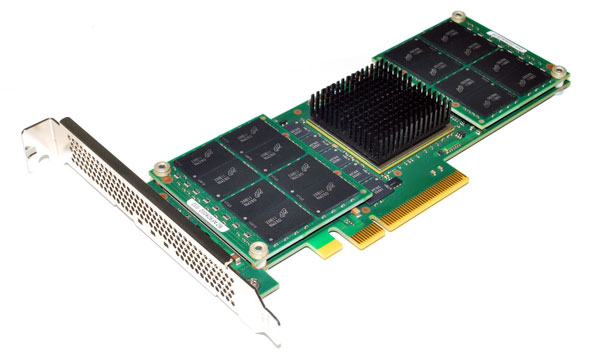Micron RealSSD P320h PCI Express SSD Review
Micron P320h PCIe SSD Up Close
The Micron P320h is a rather elegant half height, half length design that will fit in a number of chassis form factors from full height ATX boxes to 2U servers or 1U servers with a riser card. Micron provides backplane brackets for both half or full height setups (full height seen below).










The card has a rather small heatsink mounted atop the IDT ASIC. Micron notes the card requires minimal airflow, specifically 1.5m/s or 300 LFM. In a server chassis especially, this isn't an issue. The 700GiB card we tested is compromised of a base board and two daughter cards, each with 250GiB of Micron 34nm SLC NAND on them. In total the P320h 700GiB card has a full 1TB of memory on board, the excess of which is used for wear-leveling, parity data and maintenance. Since the drive is based on SLC NAND technology, it has a very high lifetime endurance specification of 25PB, which is almost two times that of Intel's MLC-based SSD 910, for example. Unfortunately, SLC NAND, as we noted earlier, also comes at a significant price premium, especially in 34nm manufacturing process technology. In the future, Micron plans to release 25nm SLC NAND memory, which should help mitigate cost significantly.

Also on board the P320h is a little over 2GB of DDR3-1333 cache memory that is also manufactured by Micron. There are nine 256MB chips in total here allocated for fast map table data look-ups across the NAND array.

The IDT PCI Express Flash Controller on board the P320h configures what is essentially a RAID-5 array that stripes data across all four 250GiB SSD memory modules on the card. Micron calls their custom algorithm "RAIN" which is short for Redundant Array of Independent NAND. RAIN employs a "7+1 RAID 5" architecture where 1 parity element is allocated for each 7 storage elements (blocks and pages). Though the P320h employs a hardware ECC engine on board as well, this is not sufficient for data recovery and device resilience over the life of the SSD. RAIN allows a real-time parity check and in the event a block of data is flagged with an error, the data is recovered and moved into a wear-level algorithm state. This all happens seamlessly to the application or user, in the background. Error data is also gathered and tracked on internal logs of the drive and can be displayed via SMART health monitoring functions.


Speaking of health monitoring, Micron also offers a tool suite with the P320h called RealSSD Manager. In addition to SMART (Self Monitoring and Analysis Reporting Technology) monitoring and message status, you can check the drive's active, current performance throughput as well as life time remaining on the drive, and controller temperature. These tools should be particularly useful for Data Center Managers looking to see how a drive is performing under load and if current thermal management solutions are getting the job done keeping the P320h cool. The percent life remaining monitor is a particularly simple yet hugely useful tool that we'd like to see employed on more SSD products in general moving forward. Obviously, it takes the guess work out of SSD health status monitoring.






